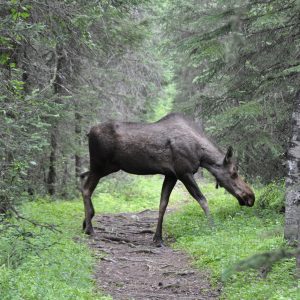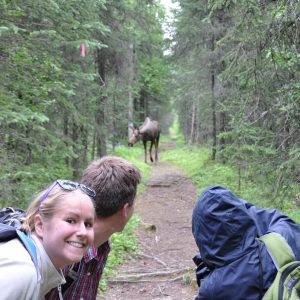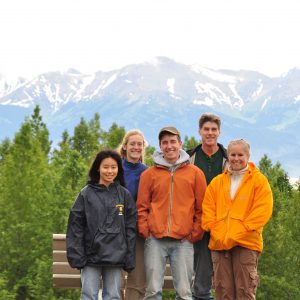
We both took long, cross-country road trips to get to Las Cruces. This gave us many mundane hours speeding through vast expanses of desert to contemplate what we were getting into. We had a general idea, but many of the details remained hazy. The most we could tell interested friends and family was that we would be collecting seeds in the deserts of Mew Mexico for a program called Seeds of Success. Arriving in Las Cruces was a bit of a shock. We are both from metropolitan areas and assumed that the second largest city in New Mexico would look similar to our hometowns: tall buildings, busy streets. Instead, we were met with a sprawl of short, boxy houses, all painted in earth tones, interspersed with a few strip malls and grocery stores. We couldn’t believe it when our mentor, Mike Howard, showed us the tallest building in Las Cruces: a six story Bank of the West building.
A different kind of surprise came later, in the form of a visitor to our new home in Dripping Springs Natural Area, a beautiful park where we are graciously allowed to live. After getting settled, we heard a scuffling noise coming from the bathroom. It seems that a scorpion had found its way up the shower drain and was examining our bottles of shampoo. Sarah had heard stories of a scorpion’s venomous sting totally incapacitating a man for several days, causing him a pain he compared to dying. Believing that we faced a similar fate if we got too close to the new resident of our shower, we squashed it with the long handle of a broom. When Mike told us the next day that scorpions in this area are not venomous, and will deliver an injury on par with a bee sting, we both felt foolish.
The nervous, unprepared feeling with which we faced this scorpion was not new to us. Before we arrived, we shared many uncertainties about the life we would be living for the next five months: would we like our new apartment? Would we be friends with our new roommate/coworker? Would we like Las Cruces, our new home? Although we could soon agree that the answer to the first two questions was yes, the third was still undetermined. And the job itself was also a mystery: after two days in the field, we had driven a lot, learned many of the plant species, and gotten out at a few locations to assess plant populations, but it was hard to tell exactly where it was going. And, with that, we set off for another long road trip, to our training conference at the Grand Canyon.
Training was better than either of us could have expected. We were happy to meet other interns, some seasoned and some new. We were also amazed by the enthusiasm, thoughtfulness, and relatability of the staff. In every session we attended, the speakers seemed knowledgeable and interested in not only their area of study, but in our understanding as well. Krissa and Marian definitely put together a great program. When training ended for the day, there was always something to do: hiking the trails of the grand canyon, getting to know other interns, attending an awesome ethnobotany lecture, or making s’mores on the rim of the canyon (where we saw a triple rainbow!).
For us, training was exactly what we needed. The staff helped us to understand the direction and purpose of our new job and gave us a bounty of practical advice to help us accomplish the tasks ahead. We understood the necessity of long trips to distant locations, even when we could not be certain that there would be seeds to collect. The program and exercises we completed helped us see the difficulty of finding a harvestable natural population of wildflowers, and the importance of collecting local seed. We left feeling more confident in our own abilities, and saw how our work fit into the bigger picture of conservation genetics and local restoration projects. As the training session came to a close, we left with a renewed sense of purpose.
Maybe it was just driving home on the back roads through the expanse of open lands punctuated with quiet little towns that made Las Cruces seem like Tokyo in comparison, or maybe it was a general optimism that we brought back from our training, but we were glad to come home to Las Cruces and found ourselves looking at the city with a fresh perspective. We celebrated the Fourth of July by sitting on the hill near our house and watching fireworks being set off in different neighborhoods across the sprawl of Las Cruces, the boom of the explosions drowned by the chirps of cicadas. It was new, and it was different, but it was nice. It could be home.
Finally, we are proud to say that we’ve stepped up our wildlife relations abilities. Just this morning, we spotted another scorpion scurrying into our room to find a home underneath Sam’s bed. This time it was, or seemed to be, a much smaller, less-threatening scorpion. Rather than blindly mashing the broom handle under the bed, we coaxed it out, caught it in a cup and brought it outside. With some nervousness, we released it, under the conditions that it would tell all of its friends of our amnesty and none of them would venture into our room again.




























